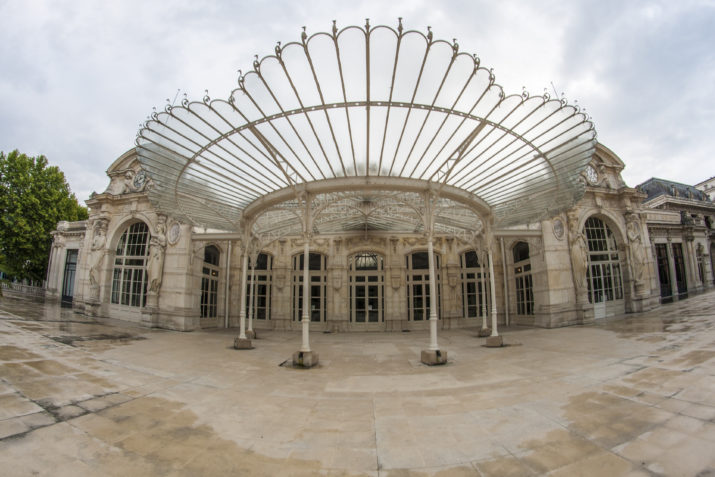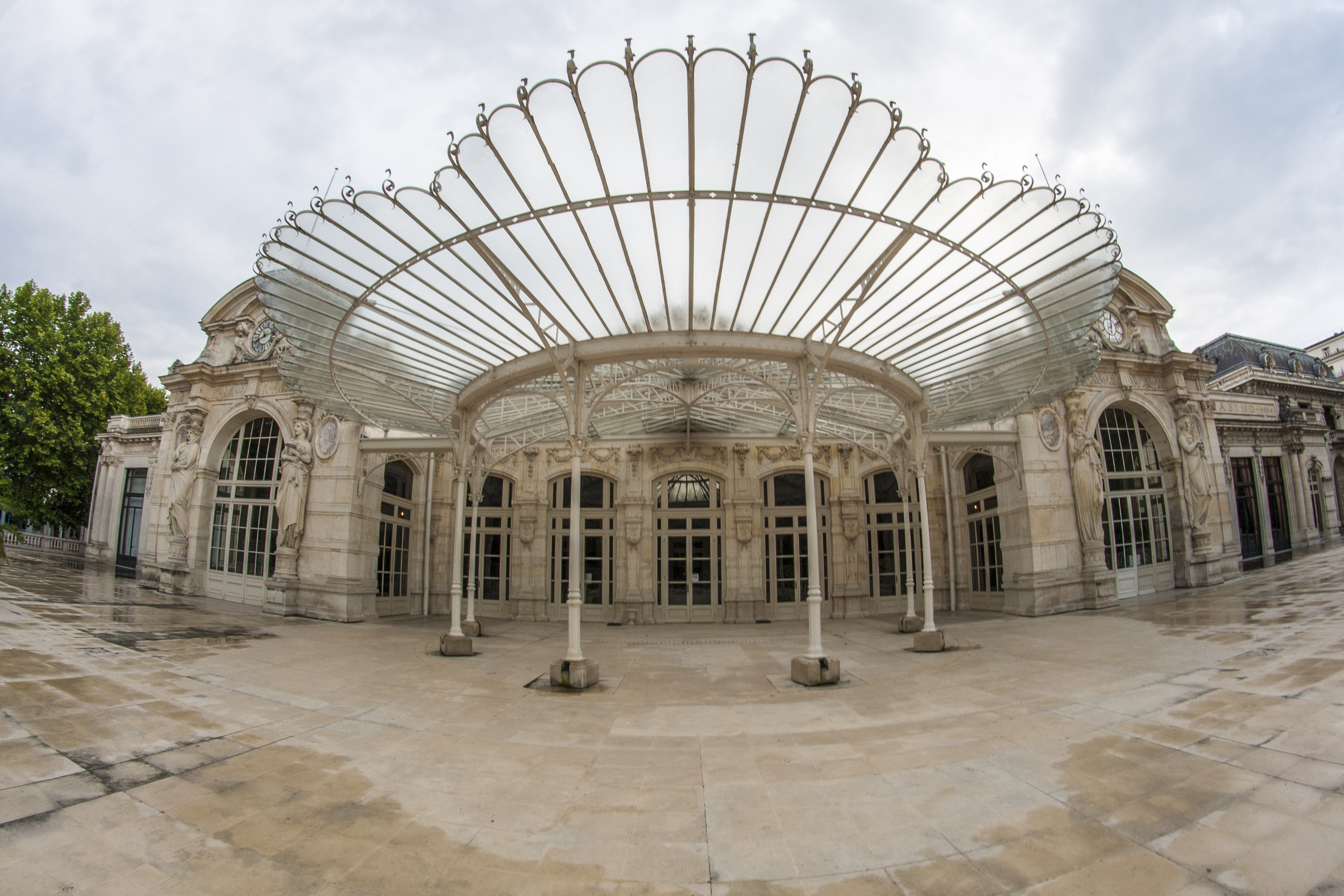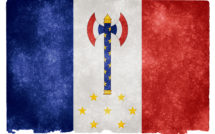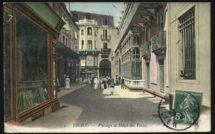

This is part of a roundtable, Author-Meets-Critics: Vichy contre Vichy, Une capitale sans mémoire by Audrey Mallet
In Vichy contre Vichy: Une capitale sans mémoire, Audrey Mallet, a native of Vichy, has written a highly informative and readable account of how the residents of that city, a famous and popular spa center, experienced the Second World War, when their hometown became the provisional capital of France, followed by their lingering and evolving memories of the war years. Whereas most of the literature addressing Vichy and the Second World War focuses on the political action of the government (État Français) under Marshal Philippe Pétain, Mallet explores the perceptions of the locals, the citizens of Vichy, during the war and their choices of remembering and forgetting in the seventy-five years thereafter. As Mallet notes, a few historical studies, such as Michèle Cointet’s Vichy capitale 1940-1944, published in 1993, have focused on the local history of Vichy during the war, although with less attention to the private individuals there.[1] Mallet’s history is bottom up rather than top down, unusual among the histories of Second World War France. Conceptually, she divides the book into two halves, discussing first the many ways in which the residents of Vichy experienced the years when their city was the provisional capital and then turning to what she terms the “duty of memory” as opposed to the “right to forget.”[2]
As Mallet writes in her introduction, her purpose is not only to write a microhistory of the Vichy community but rather to use it to show the workings of larger historical forces in a “space-time” continuum.[3] Her book is very much enriched, for example, by two chapters that focus on the impact of the French colonists, or pieds-noirs, in Algeria who came in large numbers for the spas and played a significant role in shaping the political culture of the city both before and after the war. Vichy contre Vichy is published as one in the collection Une nouvelle histoire du temps présent, a series under the direction of Denis Peschanski and Henry Rousso, two prominent historians of Second World War France. Mallet makes extensive use of local archives, including those of the Allier Department and municipal archives in Vichy, together with personal interviews and the extensive secondary literature about the city. Uncovering the private feelings of the local population, especially with a highly censored press during the war years, as Michèle Cointet noted, can be difficult.[4]The Vichy city archives, Mallet adds, are uncatalogued, thereby increasing the researcher’s dependence on the expertise of local archivists in ferreting out relevant source material. Being a native of the city also helped in arranging interviews and encouraging the local people to express their feelings about their city’s wartime role. She adds a dimension to her work by using non-textual sources such as monuments as testimonials in the construction of memory.[5]
Mallet addresses the prewar history of Vichy as a spa center, reaching a turning point with the construction of a railway station under Napoleon III, which brought an extended clientele and made it internationally famous, evidenced in an article in the New York Times in 1876.[6] With the German occupation of much of northern France, including Paris in June 1940, Vichy was chosen as the provisional capital. It was in the unoccupied zone, had large hotels that could accommodate the government offices, and a modern telephone system. The consequences of this choice for the locals are discussed in Chapter 2. By September 1940, the city’s population had grown to 120,000—some five times its prewar size.[7] Even under wartime conditions, Vichy’s spas continued to attract visitors and some of the restaurants there were able to offer better food than was available elsewhere in France. As Mallet notes, the arrival of the government was at first advantageous for the city. Its presence provided more jobs and some hoped that it would help protect the local population from the hardships of war experienced elsewhere in France. As time passed, however, it became clear that spa activity would not return to prewar levels anytime soon. The arrival of the Germans after they occupied the southern zone in November 1942, together with the establishment of the collaborationist Milice there, intensified the fear of violence. Most of the city’s inhabitants withdrew into their private lives and “waited for the storm to pass.”[8]
Mallet turns next to the political views among the local people in Vichy. While many admired Marshal Pétain, a hero of the First World War, who in addition to being the Head of State was now a neighbor, perspectives were nuanced, with individuals sometimes changing their opinions during the four-year occupation period. The locals ranged from a few pro-Nazi collaborationists through those who collaborated because they felt they had no choice; to vichysto-résistants, who worked for or with Pétain in the belief that he would join the Resistance when the opportunity came, and finally different degrees of resistors. Mallet is especially good at describing the shades of opinion, emphasizing that often it cannot be known today what a person was thinking some seventy-five years ago.[9]
As she takes up the story of the local Jews, Mallet shows that, as elsewhere in France, the population of Jews increased during the 1930s as refugees entered from Central and Eastern Europe. With the German invasion of northern France in the spring 1940, many of these refugees, together with Jews from Belgium and the Netherlands, fled south, ending up in Vichy and other cities. Mallet notes that whereas 144 Jews were deported out of France from the city of Vichy, a relatively small number in comparison to other French cities, many more were expelled from Vichy to other French sites, where they were stranded and subject to persecution. Some 3,500 foreigners, 95 percent Jewish, were expelled from Vichy between August and October 1940, even prior to the enactment of national legislation restricting the numbers and activities of foreigners and Jews.[10] Again, the fates of individual Jews varied widely. Some, such as the historian Robert Aron, who later wrote his Histoire de Vichy (1954), were saved because of personal connections with government officials.[11] In total, the Jewish population in Vichy declined from “several thousand” in 1940 to some 600 in 1943 and a “handful” in 1944.[12]
Mallet begins the second half of the book by addressing the post-liberation purges and the complex issues of how the Vichy residents remembered—or chose not to remember—the years when their city was the provisional capital of France. Private interests combined with a desire to remake an image of a “national” France as those accused of collaboration replaced resistors in the prisons of France in general and Vichy as well.[13]
In one of the main themes of her book, Mallet points out that Vichy, however, was set apart from other French locales by its association with the Pétain government, an issue that has continued to vex some in the city through the present. In this sense, the post-liberation purge failed because it did not end the stigma attached to the city and thereby “rehabilitate the name of Vichy.”[14] Defenders of the city’s reputation have often emphasized a distinction between the terms “Vichyiste,” referring to those who supported the Pétain government, and “Vichyssois,” the inhabitants of the city who had played no role in the État Français.[15] Discussing “heroes and victims”, Mallet notes that the “Vichyssois” suffered in three ways, first as victims of the “bad luck” [malchance] of their city having been chosen as the seat of Pétain’s government, secondly as having shared the same privations with the rest of France during the Occupation, and thirdly having seen their city bear the opprobrium for a government and occupation that it had not sought. Even during the war, she adds, “Vichy” had become a term of opprobrium, evidenced in the 1942 American film “Casablanca” in which a local police officer tosses away a bottle of Vichy water, indicating his break with the policy of collaboration.[16] This was not an isolated incident in English-language usage. Vichyssoise, a soup made of potatoes, leeks, and cream, usually served chilled, appeared in a 1941 Escoffier cookbook published in English under the name “Crême Gauloise” and in 1943 a New York restaurant listed it as “de Gaullesoise.”[17]
This opprobrium, Mallet continues, did not cease with the end of the war. Surveying Le Monde’s usage of the term “Vichy” during the immediate postwar years of 1944-1949, she found forty-one references to Vichy, of which thirty-three related to the Pétain government.[18] The negative associations with the war years, she suggests, were largely overcome by the early 1950s when the spas and hotels had been reopened. People in the city wished to “turn the page” and a succession of mayors said little, if anything, about the war. The promotion of tourism was seen as more important than the cultivation of memory and Vichy became a “site of non-memory” of the Second World War.[19]
As Mallet repeatedly points out, the history of Vichy as the provisional wartime capital and its history as a spa center are deeply intertwined. Nowhere is this more evident than in the city’s role as host for large numbers of pieds-noirs who visited during the interwar years and especially during the 1950s and early 1960s while the Algerian war for independence was taking place. Mallet addresses the economic impact of these visitors bolstering the spa tourist trade. Politically, they favored the French military efforts to retain their colony and also cast a more positive light on the Pétain years. To use Mallet’s term, the political culture of Vichy grew more right-wing or became more droitifiée.
The creation in 1951 of the Association pour défendre la mémoire du maréchal Pétain [ADMP], followed by its purchase of Pétain’s apartment in Vichy’s Hôtel du Parc in 1960, were, according to Mallet, outward manifestations of a growing nostalgia for Pétain.[20] The influx of pieds-noirs following the end of the Algerian War had a greater impact on what she calls the “droitification” of Vichy than did the end of the Second World War.[21] I experienced a similar phenomenon on a far smaller scale when, as an undergraduate in New York City, I became acquainted with several Francophone students who had fled Egypt following the 1956 Suez Crisis and had become strongly mobilized toward the political Right.
Viewing the period from 1980 through 2000 as one of “national obsession, local silence,” the title of Chapter 9, Mallet points to the conflicting desire to increase tourism, more urgent with a postwar decline in spa visitors, with the wish to forget the 1940-1944 period. Frequently, she writes, an effort to silence an issue may in fact result in intensified discussion of it, even if surreptitiously. There is, she notes, a “profound disorientation” in the mind of the visitor gazing at the Hôtel du Parc, a magnificent late 19th century structure, while contemplating its wartime history.[22] In 2010 Mayor Claude Malhuret complained again that the citizens of Vichy had been victimized twice, first by being expelled from their homes and hotels to make room for the government offices in the summer of 1940, and secondly by the opprobrium of the postwar association of the city with the État Français.[23] The desire to forget, she adds, has led to the ignoring of the fate of the local Jewish population during the war as well as a confused memory of the events of 10 July 1940, when a majority of the National Assembly voted full powers to Pétain.[24]
Economic pressure to increase tourism, however, has proven irresistible. A privately run walking tour of “thermal,” or spa, Vichy was organized during the 1980s but, Mallet writes, so many participants asked questions about the Second World War that the organizers arranged a tour specifically devoted to it.[25] In 1987, The Vichy Tourism Office took charge of the walking tour under the name sites vichyssois du régime de Pétain [Vichy Sites of the Pétain Regime]. On June 9, 2010, I participated in this tour, now called “Vichy, capitale de l’Etat français 40-44[Vichy Capital of the French State], offered by the Office du Tourisme, and was one of nine guests in the group, excluding the guide. One visitor was German, the others all spoke French. The group included two middle-aged French couples, two additional middle aged men, and a young woman, perhaps in her twenties, who appeared to be a student as she took extensive notes. The relatively small number of participants was due in large part to rainy weather on that day. Extrapolating, however, on a seasonal basis, the tour, offered largely during the summer months, may have attracted some two to three thousand visitors per year, a relatively small number compared to Parisian sites such as the Eiffel Tower but more significant for a small city such as Vichy.[26]
Mallet concludes by arguing that Vichy is an anomaly, not only in France but in Europe generally, in its efforts to forget or repress its Second World War memory.[27] How unique Vichy is may be difficult to establish as it is much easier to write the history of sites that publicize their past with monuments and memorials, such as those commemorating the 1944 Battle of Normandy or the liberation of Paris. One is reminded, for example, of the controversies around the postwar legacy of the house in which Hitler was born in Braunau, Austria. Many there wished only to forget the history of the house.[28] Mallet has succeeded in writing an excellent microhistory—to use her term—that transcends into larger issues of memory and repression of memory, public and private. Her discussion of the roles of the pieds-noirs is especially important in the Vichy story. She indicates in many places that conclusions are difficult to draw because of lack of evidence and difficulties in penetrating the private thoughts of locals seeing Jews being expelled during the war, or later residents’ personal and private reflections on the war years. Many of the people in Vichy after 1940 were new arrivals and she emphasizes that their perceptions could well have been different from those of the more longstanding residents. As she notes in discussing the residents’ feelings of having suffered unjust blame, there was at least among some an often unspoken resentment against the rest of France. In this sense, the book might also have been titled Vichy contre France.Looking ahead, one wonders what effect, if any, the Internet has had and will have on the residents’ perceptions of their history in Vichy and whether it will in any way change the repressed memory that Mallet describes.
It should not be surprising that many in Vichy prefer to associate their city with what they perceive as the halcyon days of the late-nineteenth and early-twentieth centuries. As Mallet notes, much of the architecture dates to that period, contributing to making Vichy a very pleasant and livable small city, described by Julia Pascal in 2002 as a “fairy-tale landscape.”[29] Bertrand de Solliers, who with Paule Muxel made the film L’Année dernière à Vichy in 2008, told me that while he could live in Paris, he much preferred life in Vichy.[30] In many places in her book, after discussing at length different aspects of the Vichy story since 1944, Mallet notes that this all goes beyond the purview of most Vichy residents who show little interest in their city’s wartime role. Alain Carteret, a local historian of Vichy, alluded in 2006 to the memory of its role in the Second World War as a “continual theme that as much as it interests journalists, does little for the readers!”[31]
Wars and their excesses tend to lose their immediacy in the course of time. The Second World War is likely to be progressively added to the long sequence of wars in French history, especially as those who experienced it pass on. Perhaps it will be tourism that emerges triumphant in the Vichy story in a way similar to the account in the German film Am Ende kommen Touristen [At the End Come Tourists] of 2007. Filmed at Auschwitz, it tells the story of a young man from Berlin, posted to a youth camp nearby where he only learns about its history from a survivor and a young woman guide.[32] Such is the fading of memory. In the meantime, we should thank Audrey Mallet for a well-documented and argued study of the small but significant city of Vichy.
Bertram M. Gordon is Professor Emeritus of History at Mills College in Oakland, California. His most recent book is War Tourism: Second World War France from Defeat and Occupation to the Creation of Heritage (Cornell University Press, 2018). He is the author of Collaborationism in France during the Second World War (1980) and editor of The Historical Dictionary of World War II France: The Occupation, Vichy and the Resistance, 1938-1946 (1998). He co-edited “Food and France: What Food Studies Can Teach Us about History,” for French Historical Studies (2015), and has written on the history of chocolate in France, England, and California, as well as the 1968 revolts in France, and the history of Vichy as a spa town. He currently serves on the Editorial Board of the Journal of Tourism History and is General Secretary of the International Commission for the History of Travel and Tourism, affiliated with the International Committee of Historical Sciences.
Vichy contre Vichy: Une capitale sans mémoire
By Audrey Mallet
Publisher: Belin
Paperback/297 pages/2019
ISBN: 978-2-410-00961-3
[1] Audrey Mallet, Vichy contre Vichy: Une capitale sans mémoire (Paris: Belin, 2019), p. 12.
[2] Mallet, p. 11.
[3] Mallet, pp. 12-13.
[4] Michèle Cointet, Vichy capitale 1940-1944 (Paris: Perrin, 1993), p. 93.
[5] Mallet, pp. 13-14.
[6] Mallet, pp. 17-18.
[7] Mallet, p. 30.
[8] Mallet, pp. 54-55. My translation.
[9] Mallet, p. 75.
[10] Mallet, pp. 94-95.
[11] Mallet, p. 99.
[12] Mallet, pp. 112-113.
[13] Mallet, pp. 126-127.
[14] Mallet, p. 134.
[15] Éric Conan, “Vichy malade de Vichy,” L’Express (26 June 1992), p. 36. This article was published during the filming of “Pétain” by Jean Marbœuf, much of it in Vichy.
[16] Mallet, p. 153.
[17] “Vichyite,” Oxford English Dictionary, 2nd edition (Oxford: Clarendon Press, 1989), XIX, p. 603.
[18] Mallet, pp. 153-154.
[19] Mallet, pp. 166-167.
[20] Mallet, pp. 196 and 206.
[21] Mallet, p. 192.
[22] Mallet, p. 222.
[23] Mallet, p. 227.
[24] Mallet, pp. 234 and 237-238.
[25] Mallet, pp. 239-240.
[26] Bertram M. Gordon, War Tourism: Second World War France from Defeat and Occupation to the Creation of Heritage (Ithaca, New York: Cornell University Press, 2018), p. 180 and 180, note 100.
[27] Mallet, pp. 242 and 252.
[28] Bethany Bell, “Hitler’s old house gives Austria a headache,” BBC News, 29 December 2014, <https://www.bbc.com/news/world-europe-30539384>, retrieved 5 August 2019.
[29] Julia Pascal, “Vichy’s shame,” The Guardian, 11 May 2002; <https://www.theguardian.com/world/2002/may/11/france.weekend7>, retrieved 9 August 2019.
[30] Author’s conversation with Bertrand de Solliers, Vichy, 7 June 2010.
[31] “Le numéro 9 de MODERGNAT (mai 2005), avec le maréchal Pétain et Claude Malhuret en couverture, est titré Vichy face à son passé, faisant allusion à la formule éculée d’Henry Rousso Un passé qui ne passe pas. Ce thème passionne toujours autant les journalistes, à défaut de passionner les lecteurs !” See Alain Carteret, Vichy Charme (Olliergues: Editions de la Montmarie, 2006), p. 68, cited in “Patrimoine Vichy,” <http://pagesperso-orange.fr/carteret/Patrimoine%20Vichy.htm>, retrieved 7 October 2009.
[32] The film was shown in the 2007 Cannes Film Festival and won the prize for best fiction film at the Pessac Historical Film Festival. See Gordon, War Tourism, p. 222.
Photo: Opera in Vichy | Shutterstock
Published November 15, 2019.




